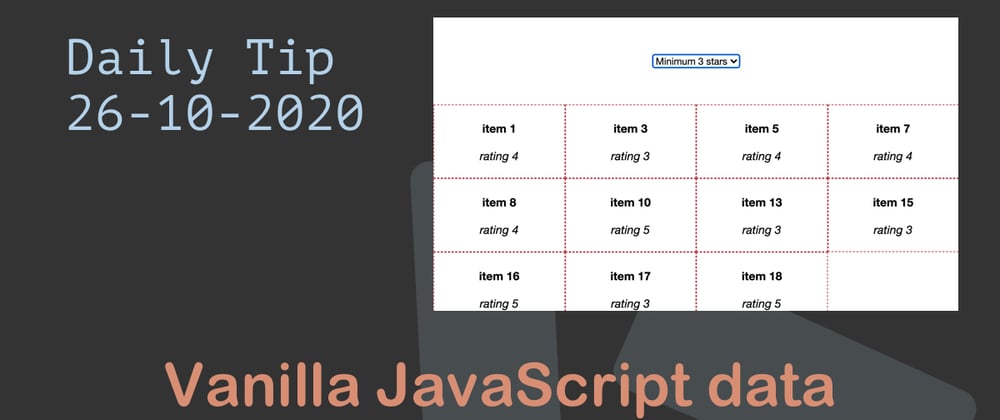Today we will be creating a custom filter element based on data attributes in Vanilla JavaScript.
This means that we will have a filter mechanism select list and a list of elements with specific data-attributes on them.
The end result will look like this Codepen. (Choose an option to see the effect)
HTML Structure
We need a select list for the dropdown and a ul with random list ratings to get started.
It will look something like this:
<select id="rating">
<option value="">Choose a rating</option>
<option value="5">Minimum 5 stars</option>
<option value="4">Minimum 4 stars</option>
<option value="3">Minimum 3 stars</option>
<option value="2">Minimum 2 stars</option>
<option value="1">Minimum 1 stars</option>
</select>
<ul>
<li data-rating="4"><span>item 1</span><i>rating 4</i></li>
<li data-rating="2"><span>item 2</span><i>rating 2</i></li>
<li data-rating="3"><span>item 3</span><i>rating 3</i></li>
<li data-rating="1"><span>item 4</span><i>rating 1</i></li>
<li data-rating="4"><span>item 5</span><i>rating 4</i></li>
<li data-rating="1"><span>item 6</span><i>rating 1</i></li>
<li data-rating="4"><span>item 7</span><i>rating 4</i></li>
<li data-rating="4"><span>item 8</span><i>rating 4</i></li>
<li data-rating="1"><span>item 9</span><i>rating 1</i></li>
<li data-rating="5"><span>item 10</span><i>rating 5</i></li>
<li data-rating="1"><span>item 11</span><i>rating 1</i></li>
<li data-rating="2"><span>item 12</span><i>rating 2</i></li>
<li data-rating="3"><span>item 13</span><i>rating 3</i></li>
<li data-rating="1"><span>item 14</span><i>rating 1</i></li>
<li data-rating="3"><span>item 15</span><i>rating 3</i></li>
<li data-rating="5"><span>item 16</span><i>rating 5</i></li>
<li data-rating="3"><span>item 17</span><i>rating 3</i></li>
<li data-rating="5"><span>item 18</span><i>rating 5</i></li>
<li data-rating="1"><span>item 19</span><i>rating 1</i></li>
<li data-rating="2"><span>item 20</span><i>rating 2</i></li>
</ul>
For now let's get cracking in making this look a little bit better.
CSS Styling
select {
margin: 50px auto;
display: block;
}
ul {
display: grid;
grid-template-columns: 1fr 1fr 1fr 1fr;
}
ul li {
display: flex;
align-items: center;
justify-content: center;
border: 1px dashed #ba3b46;
flex-direction: column;
height: 100px;
}
ul li.hidden {
display: none;
}
ul span {
font-weight: bold;
margin-bottom: 20px;
}
We set some margin on the select element to space it out a little bit better.
Then we convert the ul into a grid with four columns.
And make the list items nicer, and a bit more spacious.
Vanilla JavaScript data-attribute filter
Now, let's enter the magic part, JavaScript.
First, we want to get the select item by its ID.
const rating = document.getElementById("rating");
The next thing we need is the list items. We use a querySelectorAll to get them.
const elements = document.querySelectorAll("li");
Let's add an eventListener to our select item. It will be called every time the value changes.
rating.addEventListener("change", function () {
// Code here
});
Inside that, we need to get the value of the rating first.
let value = rating.value;
// 1,2,3,4, or 5
Then we want to loop over all our list items.
[...elements].forEach((element) => {
// Code here
});
Within this block, we want to check if we have a value at all. Else we need to reset all the items.
Once we have a value, we must check if the rating is lower than the value.
if (value === "") {
// Select empty option
element.classList.remove("hidden");
} else {
// Get the rating for this list item
const rating = element.dataset.rating;
// Check if the rating is lower than the value
if (!rating || rating < value) {
// Hide the element
element.classList.add("hidden");
} else {
// Show the element
element.classList.remove("hidden");
}
}
The whole code will look like this:
const rating = document.getElementById("rating");
const elements = document.querySelectorAll("li");
rating.addEventListener("change", function () {
let value = rating.value;
[...elements].forEach((element) => {
if (value === "") {
element.classList.remove("hidden");
} else {
const rating = element.dataset.rating;
if (!rating || rating < value) {
element.classList.add("hidden");
} else {
element.classList.remove("hidden");
}
}
});
});
There you go. We now have a vanilla JavaScript filter based on data-attributes.
Thank you for reading, and let's connect!
Thank you for reading my blog. Feel free to subscribe to my email newsletter and connect on Facebook or Twitter



















